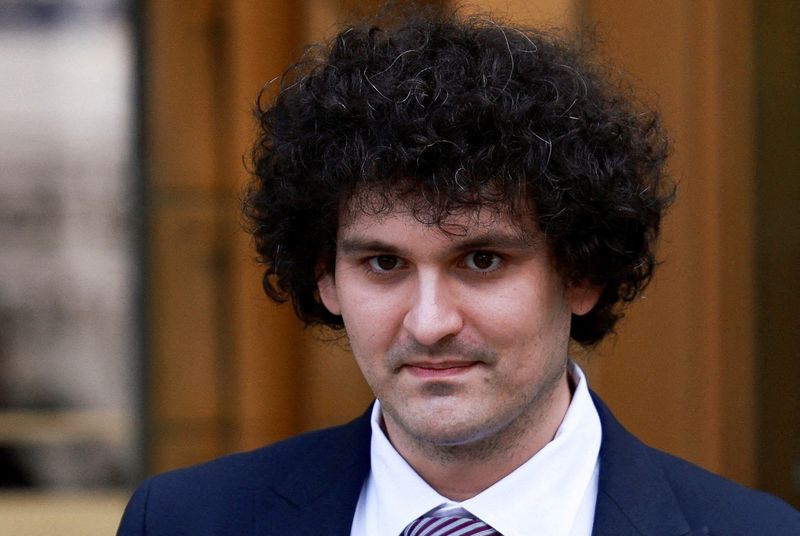Sam Bankman-Fried admits ‘mistakes’ but testifies he did not defraud anyone
2023.10.27 15:40

© Reuters. FILE PHOTO: Indicted FTX founder Sam Bankman-Fried leaves the United States Courthouse in New York City, U.S., July 26, 2023. REUTERS/Amr Alfiky/File Photo
2/2
By Jody Godoy and Luc Cohen
NEW YORK -FTX founder Sam Bankman-Fried, testifying in his own defense at his fraud trial on Friday, said a “lot of people got hurt” when the cryptocurrency exchange collapsed last year, but insisted he did not defraud anyone or steal billions of dollars from customers.
Bankman-Fried fielded questions from his own lawyer in his first day of testimony with jurors present, admitting to making “mistakes” such as not implementing a dedicated risk-management team. The 31-year-old former billionaire’s answers conformed to his longstanding argument that he overlooked some things as an entrepreneur building a fast-growing company from scratch but never set out to steal people’s money.
“We thought that we might be able to build the best product on the market,” Bankman-Fried testified in Manhattan federal court. “It turned out basically the opposite of that. A lot of people got hurt – customers, employees – and the company ended up in bankruptcy.”
Bankman-Fried answered questions on Thursday without the jury present as the judge assessed what parts of his testimony would be admissible in the trial.
Prosecutors have accused Bankman-Fried of using FTX customer funds to prop up his crypto-focused hedge fund, Alameda Research, make speculative venture investments and donate more than $100 million to U.S. political campaigns. He also faces charges of scheming to cheat Alameda’s lenders and FTX investors.
Bankman-Fried has pleaded not guilty to two counts of fraud and five counts of conspiracy. He was arrested in December 2022, one month after FTX declared bankruptcy following a wave of customer withdrawals. If convicted, he could face decades in prison.
Prosecutors have said he directed that Alameda be given special trading privileges on FTX, such as a $65 billion line of credit and an exemption from having its positions liquidated if it posted losses. They have said those privileges let Alameda siphon deposits from the exchange’s unsuspecting customers.
Responding to questions from defense attorney Mark Cohen, Bankman-Fried occasionally looked toward the jury and spoke in calm, measured tones as he sought to reframe those actions as reasonable business decisions made in response to problems the exchange faced.
However, Bankman-Fried said he was not aware of how exactly his decisions as chief executive officer were carried out by his colleagues. Three close former colleagues have pleaded guilty and testified that they committed financial crimes at Bankman-Fried’s behest.
Prosecutors will be given their chance to cross-examine Bankman-Fried in front of the jury once the defense is finished questioning him. Prosecutor Danielle Sassoon objected several times that Bankman-Fried was veering off topic as he gave lengthy answers to Cohen’s questions.
A ‘MARKET-MAKER’
Alameda, Bankman-Fried said, was a “market maker” that served to boost volume on FTX, and thus could borrow money from the exchange to make trades.
Bankman-Fried said he grew concerned about the potential for an “erroneous” liquidation of Alameda’s assets, which would be “catastrophic” for the exchange. He said he directed two FTX computer programmers, Nishad Singh and Gary Wang, to implement a feature to prevent this from happening.
He said he asked them to build a feature that would stall any automatic liquidation, and said he did not know at the time that what his colleagues put in place was a feature that allowed Alameda to carry a negative balance on the exchange.
Prosecutors have said Bankman-Fried also stole funds by having customers at FTX, which initially lacked its own bank accounts, deposit their funds in accounts controlled by Alameda, which then lent money to Bankman-Fried and other executives.
Bankman-Fried told the jury he “wasn’t entirely sure what was happening” with those funds, but said he assumed that if Alameda borrowed from it, it would have been recorded on the fund’s FTX account.
Bankman-Fried testified that he relied on former friends and employees at FTX and Alameda who are now cooperating with prosecutors in his criminal case – Singh, Wang and former Alameda CEO Caroline Ellison, his former girlfriend.
Bankman-Fried testified that Ellison was a good manager and trader, but not focused on “risk management,” and Wang was a friend who he “trusted and respected.” Bankman-Fried and Wang lived together in an alcohol-free, “nerdy” fraternity house at the Massachusetts Institute of Technology, the defendant said.
Bankman-Fried, who was jailed in August when U.S. District Judge Lewis Kaplan found he likely tampered with witnesses, presented a clean-cut look to the jury and was clad in a dark suit, a contrast to his trademark former casual look and mop of curly hair. He told jurors that he liked to wear shorts and T-shirts because they were “comfortable.”








